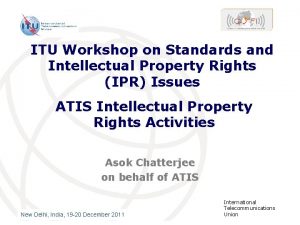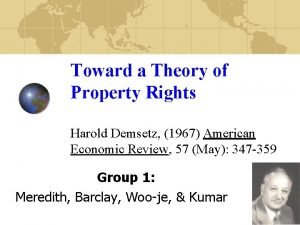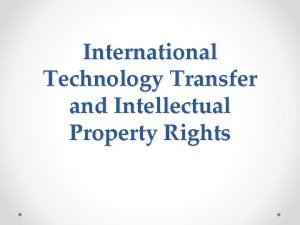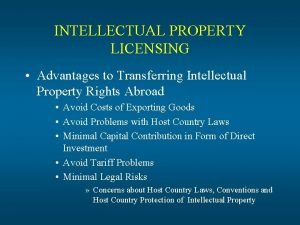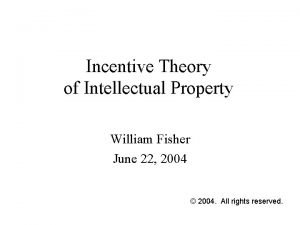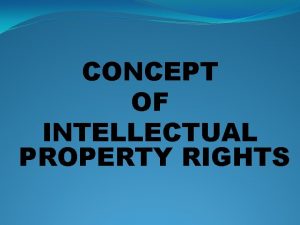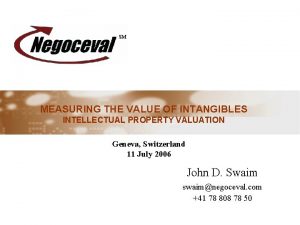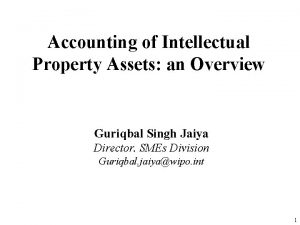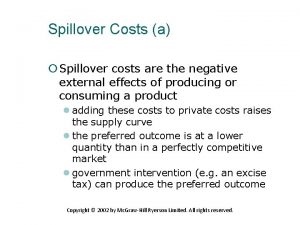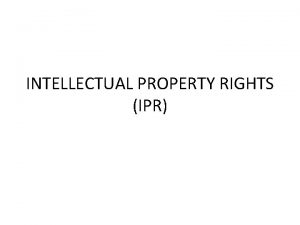Intellectual Property Rights and the Knowledge Spillover Theory

















- Slides: 17

Intellectual Property Rights and the Knowledge Spillover Theory of Entrepreneurship Max Planck Institute 9 September 2008 Jena Mark Sanders Utrecht School of Economics Max Planck Institute of Economics m. sanders@econ. uu. nl

Motivation Schumpeter and Endogenous Growth Theory Innovation vs. Invention Who gets rents? Opportunities vs. Ideas The source of vs. the bottleneck in innovation Growth and Ideas; the basic model structure Consumers Producers/Intermediates Invention, Innovation and Growth Patents and the US Patent Reform: Patents and the Bargain over Rents Incentives for Knowledge Creation Incentives for Knowledge Commercialization Outcomes

Growth and Ideas Basic Structure: Consumers 1. Willing to save 2. Demand for innovations Basic Structure: Producers 1. Make profit (imperfect competition) 2. Demand production factors

Growth and Ideas Basic Structure: Inventors/Innovators 1. Make zero-profit (free entry) 2. Need to demand R&D factors Auction off ideas at willingness to pay: Produce ideas according to:

Growth and Ideas Basic Structure: 1. Growth is positive for positive R&D 2. Sub-optimal in case of spillovers Intra-temporal knowledge spillovers Inter-temporal knowledge spillovers Positive steady state growth requires: latent demand for innovation imperfect competition appropriation of rents by new knowledge creators increasing returns to scale in aggregate production Optimal growth requires: stimulation of knowledge creation patents to internalize part of the spillovers

Patents Historical: Royal Favor and Revenue Inventions and Innovations Knowledge and Ideas Recent US reforms The Rationale: Knowledge creation is source of growth Patents reward knowledge creation Patent protection stimulates growth Incentives and Rewards: But what drives knowledge creation? And what drives invention? And what drives innovation?

A Model (Acs and Sanders 2008) Consumers of final good C Producers of final good C Labor Market Capital Market Producers of n intermediate goods

A Model (Acs and Sanders 2008) Consumers (standard)

A Model (Acs and Sanders 2008) Final Goods Producers

A Model (Acs and Sanders 2008) Final Goods Producers (R&D)

A Model (Acs and Sanders 2007) Intermediate Goods Producers

A Model (Acs and Sanders 2007) Intermediate Goods Producers (Entry) Entry-Arbitrage:

A Model (Acs and Sanders 2008) Equilibrium in labor market:

A Model (Acs and Sanders 2008) Equilibrium 1 A/n* A/n

A Model (Acs and Sanders 2008) Equilibrium Steady State:

A Model (Acs and Sanders 2008) New Features: Captures spin-out/off Captures upstream spillovers (specialization) Captures downstream spillovers (opportunities) Residual rents reward commercialization Patents transfer rents from innovators to inventors Results in line with new growth theory: Growth Sub-Optimal Both R&D and Entrepreneurs should be supported R&D more than Entrepreneurs More patent protection means more R&D… Results in contrast to new growth theory: …but also less commercialization. Too much protection may lead to lower innovation Distinguishing entrepreneurs from R&D makes a difference

A Model (Acs and Sanders 2008) In the tradition of Schumpeter we: …separate commercialization and invention, …allocate the residual monopoly rents to the entrepreneur, …assume opportunity to be a spillover. In the tradition of Romer we: …see patents as (imperfect) claims to rents, …that incentivize knowledge creation. But we show that: …patents are not needed to incentivize R&D and… …strengthening patent protection may overshoot the target, …as Jaffe and Lerner (2004) argue it has in the US.
 Trade related aspects of intellectual property rights
Trade related aspects of intellectual property rights Intellectual property in professional practices
Intellectual property in professional practices Intellectual property rights
Intellectual property rights Intellectual property rights
Intellectual property rights Harold demsetz toward a theory of property rights
Harold demsetz toward a theory of property rights Importance of intellectual property
Importance of intellectual property Intellectual property management definition
Intellectual property management definition Advantages of intellectual property
Advantages of intellectual property Intellectual property in business plan
Intellectual property in business plan Property
Property Right to intellectual property of teachers
Right to intellectual property of teachers Intellectual property law definition
Intellectual property law definition Incentive theory
Incentive theory Concept of intellectual property
Concept of intellectual property Valuation of ip
Valuation of ip Characteristics of intellectual property
Characteristics of intellectual property Discuss intellectual property frankly
Discuss intellectual property frankly Sfas 142
Sfas 142


